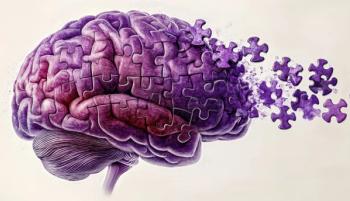
Insights Into Neuropathology Elucidated Through the Science of Sleep
Insights Into Neuropathology Elucidated Through the Science of Sleep
Better understanding of the sleep-wake cycle is proving instrumental in gaining insight into the pathogenesis of various neurodegenerative disorders. Indeed, astute documentation of sleep complaints may help neurologists identify certain neurodegenerative disorders decades before classical symptoms appear.
A key component of sleep pathology is loss of neurons in either cholinergic or monoaminergic pathways originating in the brain stem, explained Clifford B. Saper, MD, PhD, during a "Hot Topics" plenary session delivered at the Annual Meeting of the American Academy of Neurology in Boston in May. Saper, the James Jackson Putnam Professor of Neurology and Neuroscience and the Harvard Medical School chair in the Department of Neurology at Beth Israel Deaconess Medical Center in Boston, also presented similar data at the Annual Meeting of the American Society for Experimental Neurotherapeutics in March in Washington, DC.
Saper and colleagues have been at the forefront of research into the mechanisms of the sleep-wake cycle, identifying inhibitory and excitatory colonies of neurons in the hypothalamus that work as if manning a so-called flip-flop switch. "Understanding the circuitry of the brain can shed light on puzzling neurological disorders such as rapid eye movement [REM] sleep behavior disorder, narcolepsy, and catalepsy," he said.
FROM WAKING TO SLEEP
The 2 main ascending pathways that originate in the upper brain stem-1 cholinergic and the other monoaminergic-are instrumental in orchestrating the sleep-wake cycle.1 The first sends outputs to the thalamus, "opening up corticothalamic transmission, allowing sensory information to reach the cortex," Saper explained. The second sends outputs to the cerebral cortex to prepare cortical neurons to receive sensory information.
"When both pathways are firing at high rates, we are awake," explained Saper. As neuronal activity slows in the cholinergic system and virtually comes to a halt in the monoaminergic system, a person enters non-REM sleep. "Intermittently, the person will pass into REM sleep in which the cholinergic system fires back up and is going at the same rate as during wakefulness, but the monoamine system goes to zero," Saper continued.
What turns these "switches" on and off? Saper and his team have discovered that it is inhibitory neurotransmitters from neurons making up the ventrolateral preoptic nucleus (VLPO) in the hypothalamus.1,2 The VLPO, which is made of both γ-aminobutyric acid [GABA]-ergic and galaninergic neurons, sends inhibitory outputs to the components of the ascending arousal system and predominantly fires during sleep states. By inhibiting the arousal system, neurons of the VLPO allow persons to rapidly transition from wake to sleep.
This so-called flip-flop switch loses its efficiency if an imbalance or loss of neurotransmission occurs, as it does in sleep disorders and even in the course of normal aging. About 50% of neurons are lost in the VLPO in the course of the natural aging process, Saper explained. "As you lose neurons in the VLPO, you tend to fall asleep more during the day. This has a paradoxical effect. You make more transitions from sleep to wakefulness and vice versa. The switch rides closer to its transition point," he said.
He and colleagues demonstrated this point in an experimental study in which neurons were extracted from the VLPO of rats.3 The ability to sleep was compromised. The animals lost three fourths of slow wave sleep. "This happens to people with aging. We lose about an hour of sleep and have trouble getting into stage 3 and 4 sleep," Saper remarked.
Another crucial component of the sleep-wake mechanism is the activity of peptonergic orexin neurons within the lateral hypothalamus.1 "These neurons send excitatory outputs to the ascending arousal system, evoking the opposite effect of neurotransmissions from the VLPO," explained Saper. "Orexin neurons add weight to the 'on' side of the flip-flop switch and create stability. They allow a person to maintain a waking state for a 16-hour day. At the appropriate time, VLPO neurons turn off orexin and allow consolidated sleep to occur."
Orexin deficiency has been identified in a large majority (85% to 95%) of persons with sporadic narcolepsy-cataplexy.4 Conditions similar to human narcolepsy and cataplexy have been shown to occur in animals that lack orexin or its type 2 receptor.5,6 The phenomenon is not seen to a great degree in familial narcolepsy, though, and thus, the orexin deficiency may not be related to genetic predisposition.7 "It is acquired neurodegeneration or perhaps it is an autoimmune effect," Saper said.
REM ON-OFF SWITCH
Hypothesizing that excitatory orexin neurons and inhibitory VLPO neurons should intersect to inhibit REM sleep, Saper and his team searched for and found neurons that constitute a REM on-off population in the area of the pons at the level of the dorsal raphe nucleus.8
"These neurons are GABAergic. Those within the pons are REM-off neurons. Neurons adjacent to the pons-particularly in the sublateral dorsal nucleus-are REM-on neurons. It is a GABAergic double inhibitory switch," explained Saper. "It turns out that when you make lesions on either side of the switch, the switch is disinhibited; the switch flips back and forth unpredictably."
Narcolepsy is the result. "Not only can you fall asleep at the wrong time, you can get REM phenomena in a waking background," Saper explained. "So neurons in the pons can produce ascending output to the forebrain, which creates dreamlike states superimposed on wakefulness-hypnogogic hallucinations-or they can produce motor atonia during the waking state-cataplexy."
REM AND MOVEMENT DISORDERS
REM behavior disorder, in which sublateral dorsal neuron loss causes persons to act out dreams, also can occur. REM sleep behavior disorder is being recognized as a precursor to synucleopathic movement disorders such as Parkinson disease (PD), multiple system atrophy, and Lewy body dementia.9-12 (For a discussion on this formerly appearing in Applied Neurology, see the article "REM Sleep Behavior Disorder: Harbinger of Synucleinopathies?" in the September 2006 issue [neurologist version]).
According to Saper, citing Braak and colleagues' data on staging of intracerebral inclusion body pathology in PD,13 the area earliest to show degeneration is the sublateral dorsal nucleus. "The sublateral dorsal nucleus, which causes atonia in sleep, is located under locus ceruleus. If you were to map the sublateral dorsal nucleus according to criteria by Braak and colleagues, you would find that PD cerulean inclusions begin in the lower brain stem and move up but don't involve the motor system-such as the substantia nigra-until the patient is in stage 3 or 4 of disease," explained Saper. Involvement of the sublateral dorsal nucleus begins in stage 2 of the disease and is prominent by stage 3, he said. "This probably is why REM sleep behavior disorder is so prominent in patients with PD and precedes movement problems by a decade or more," noted Saper.
Thus, in recognizing sleep disorders and having familiarity with the mechanisms of sleeping and waking, markers for neurological ills can be identified early and interventions ultimately may be put in place in anticipation of overt pathology.
References:
REFERENCES1. Saper CB, Chou TC, Scammell TE. The sleep switch: hypothalamic control of sleep and wakefulness. Trends Neurosci. 2001,24:726-731.
2. Sherin JE, Shiromani PJ, McCarley RW, Saper CB. Activation of ventrolateral preoptic neurons during sleep. Science. 1996;271:216-219.
3. Lu J, Greco MA, Shiromani P, Saper CB. Effect of lesions of the ventrolateral preoptic nucleus on NREM and REM sleep. J Neurosci. 2000;20:3830-3842.
4. Thanickal TC, Moore RY, Nienhuis R, et al. Reduced number of hypocretin neurons in human narcolepsy. Neuron. 2000;27:469-474.
5. Chemelli RM, Willie JT, Sinton CM, et al. Narcolepsy in orexin knockout mice: molecular genetic of sleep regulation. Cell. 1999;98:437-451.
6. Willie JT, Chemelli RM, Sinton CM, et al. Distinct narcolepsy syndromes in orexin receptor-2 and orexin null mice: molecular genetic dissection of non-REM and REM sleep regulatory processes. Neuron. 2003;38:715-730.
7. Peyron C Faraco J, Rogers W, et al. A mutation in a case of early onset narcolepsy and a generalized absence of hypocretin peptides in human narcoleptic brains. Nat Med. 2000;6:991-997.
8. Lu J, Sherman D, Devor M, Saper CD. A putative flip-flop switch for control of REM sleep. Nature. 2006;441:589-594.
9. Hickey MG, Demaerschalk BM, Caselli RJ, et al. "Idiopathic" rapid rapid-eye-movement sleep behavior disorder is associated with future development of neurodegenerative diseases. Neurologist. 2007;13:98-101.
10. Boeve BF, Silber MH, Saper CM, et al. Pathophysiology of REM sleep behaviour disorder and relevance to neurodegenerative disease. Brain. 2007 Apr 5; [Epub ahead of print].
11. Postuma RB, Lane AE, Massicotte-Marquez J, et al. Potential early markers of Parkinson disease in idiopathic REM sleep behavior disorder. Neurology. 2006;66:845-851.
12. Boeve BF, Silber MH, Parisi JE, et al. Synucleinopathy pathology and REM sleep behavior disorder plus dementia or parkinsonism. Neurology. 2003;61:40-45.
13. Braak H, Del Tredici K, Bratzke H, et al. Staging of the intracerebral inclusion body pathology with idiopathic Parkinson's disease (preclinical and clinical stages). J Neurol. 2002;249(suppl 3):III/1-5.
Newsletter
Receive trusted psychiatric news, expert analysis, and clinical insights — subscribe today to support your practice and your patients.













